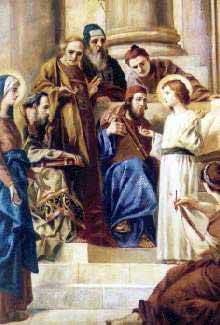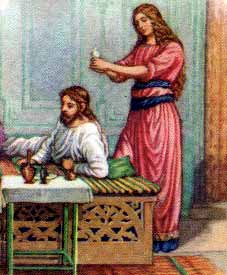
The Holy Bible

The Transfiguration
of Jesus
There are 66 books in the bible. 39 are in the Old Testament and 27 are in the New Testament.
Here are the 27 books of the NEW testament. Click on any title in the grid and it will take you down the page. Use your back key to come back to the top here.
Or you can just scroll down and see the graphics along the way.

Matthew
Matthew writes this gospel to reveal Jesus as the promised Messiah and King. He also tells us much about the life and ministry of Jesus, especially how he fulfills the promises of the OLD Testiment and how his followers should conduct their lives as citizens of God's kingdom. Matthew begins this gospel with the birth of Jesus. He closes his story with Jesus reassuring promise.
Mark
The gospel of Mark takes a fast paced approach to introducing Jesus Christ, The Son of God. Mark shows Jesus moving quickly from teaching his disciples to healing the sick people to confronting religious leaders on his way to death on the cross. Take note of Mark's sensitive portrayal of the compassionate suffering servent, Jesus, full of life and emoton and purpose. Also his call for us to be disciples of Jesus and the love Jesus showed his disciples.
Luke
Luke writes this gospel to share the good news of salvation. A physician by profession, Luke shows compassio for the people considered outcast, including tax collectors, woen and children and the poor. He also shows a deep concern for rayer, discipleship, joy and the ministry of the Spirit. This is Luke's account of the life of Jesus.
John
John's writings are designed to convince people to believe in Jesus as God in human form and, as a result to "have life".
Acts
Like a sequel to a movie, Acts picks up the action begun in the book of the Gospel of Luke. Acts is refered to the focus on the coming of the Spirit on Gods people-the church-in a new and powerful way. In ths book Luke records Christianity's amazing growth and that the revival comes not of uman effort but by the power of the Holy Spirit.
Romans
The book of Romans offers some of the most lively teachings on faith and life. IIn this letter Paul tells of God's wonderful plans for redeeming his people and setting them free for service through the power of his Spirit.

Young Jesus
1 Corinthians
Paul writes to the church he had started in Corinth, a church now struggling to live in obedience. In a letter arked by a true pastor's heart, Paul addresses problems in Christian conduct and character. Look for practical information to Christian living and relationships, as well as words abut love and the resurrection.
2 Corinthians
Paul writes this second letter a few months after the first letter. The divisions and problems addressed in 1 CORINTHIANS are still present in the church, and false teachers are challenging Paul's integrity and his authority as an apostle. Watch for practical advice on resolving conflict within the church and providing financial support for the church and for the poor.
Galatians
Paul's letter to the churches he established in Galatia cotains his classic statement of the foudational Bibical truth that a person s justified bu faith, in Christ. After warning the Galatians not to desert the gospel, Paul encourages them to live out the freedom they have in Christ.
Ephesians
Paul writes this letter so that his readers might better understand God's eternal purposes for the church. One of the purposes is to reconcile people to God and to each other through the work of Jesus on the cross.
Philippians
Paul writes to the Philippians during his first Roman imprisonment to thank them for their love and help and to warn them against false teachers. Be alert to Paul's warnings against pride and self-seeking attitude that can lead toharmful divisions. Paul provides to help you shape your thinking according to God's ways.
Colossians
During Paul's 3 year ministry in Epheses, Epaphras is converted and carries the gospel to Colosse. The young church that results then becomes the target of attack. Paul's purose in writing this letter is to refute the false teachers bt asserting the supremacy of Chist and examining what that means for eryday living.

the annointing of Jesus
1 Thessalonians
Paul founds the church at Thessalonica during his second missionary journey. Paul writes to commend belivers for growing in he Lord and to encourage them to correct some misunderstandigs. The subject of Christ's second coming permeates this letter, with almost every chapter referring to it.
2 Thessalonians
Paul writes this second letter to belivers at Thessalonica, who need clarification on the advice given in his first letter. Some people have misunderstood Paul and are so sure Jesus is coming so soon, that they stop working. While assuring the Thessalonians that Jesus is in fact coming, Paul urges his readers to concentrate on living and working with what HE has given them for today.
1 Timothy
Paul writes to Timothy with affirmation and advice on how to lead the church at Ephesus.
2 Timothy
Paul's second letter to Timothy, written shortly before Paul's death, represents the advice of someoe who knows he is at the end ofhis life. In a cold dungeon, chained like a common criminal, Paul knows that his work is done. He challenges Timothy to a more effective ministry and encourages him to persevere in his walk with God.
Titus
Titus, a close friend of Paul, helps Paul organize and lead churches in the Eastern half of the Roman empire. Paul writes this letter to Titus to help him lead the troubled church on the Island of Crete. Paul covers such matters as quaifications of church leaders, guidelines for a godly life and an emphasis on faith that overcomes division amoung belivers.
Philemon
Philemon, a believer in Colosse, owns a slave named Onesimus, who steals from his owner and then runs away. But Onesimus meets Paul and through his ministry becomes a Christian. Now he is willing to return to his master. Paul writes this personal appeal to ask Philemon to accept Onesimus as a Christian brother, not as a slave.

raising Lazarus
Hebrews
The 1st century church suffered severe persecution, and this letter is written in that setting. The intended readers seem to be Jewish Christians who are thinking of abandoning their faith and oflapsig back into Judaism. The author begs them to hold fast to their confession of Christ as Savior and Lord.
James
The book of James is written by James, probably the brother of Jesus and the leader of the Jerusalem council. The book of James has a distinctively Jewish nature that suggest it was composed when the church was still predominatly Jewish. The letter deals with the practical aspects of the Christian faith, for everyday conduct.
1 Peter
The recipients of this letter had been suffering various trials and afflications, along with a very real threat of more severe difficulties to come. Peter tuches on various doctrines and has much to say about Christian life and duties. 1st Peter has been characterized as a letter of suffering and perescution, of suffering and glory, of hope and courage. No other New Testament book so reflects the real nature and effect of God's love in Jesus Christ.
2 Peter
The same group of Christians addressed in Peter's first letter are now in danger of being misled by false teachers. Peter as a "shepherd" of Christ's sheep. not only teaches the church how to deal with false teachers but also to seek a wholesome Christian faith and practice.
1 John
The author of this letter is John, the son of Zebedee, and the author of the Gospel of John and the book of Revelation. John has 2 basic purposes in mind for this letter. (1) to expose false teachers who deny Jesus' humanity, and (2) to give belivers assurance of salvation. John stresses God's love as an example for us to follow in our relationships with each other. He encourages belivers to live right and to maintain truth by maintaining fellowship with the Lord.

Jesus doing
The foot washing
2 John
During the first 2 centuries A>D>, the gospel was taken from lace to place by traveling evangelists. Believers customarily took these missiionaries into their homes and gave them provisions when they left. Because false tachers also relied on this practice, 2nd John is written to urge discernment in supporting traveling teachers.
3 John
Itinerant teachers sent out by John were rejected in one of the churches in the province of Asia, by a dictorial leader, Diotrephes. John write to his friend Gaius a leader in the church, to thank him for his help and to encourage him in his support of ligitimate teachers. He also reproves Diotrephes for not cooperating and fo rebellig against John's leadership.
Jude
This is a personal letter to one or more of the congregations dispersed throughout the Roman empire. The dangers facing the church is from heretics and distorters of the faith. Although Jude is eager to write about salvation, he ust instead warn hs readers about immoral men eho are peverting God's grace. This letter advises belivers t strengthen their relationship to God with prayer and mutual support.
Revelation
John writes what Jesus Christ reveals to him in rder to comfort belivers suffering for their faith. It is a book of hop, for i's central message that God and goodness will triumph over evil. Look for a combination of warnings and encouragements here...

the Good Samaritan
End of the
NEW TESTAMENT

To return to the cover page , where the Guest Book is at {wink} CLICK HERE.

|